This is my inaugural post for Art Jewelry Elements, and I am so glad to be here! (You can read more about me and why hammers make me a little weak in the knees
here if you're interested.) I am a nut for all things metal, and I recently took a class in metal etching to try and expand my toolbox of techniques a little bit, since I don't own a rolling mill to impress patterns into the metal I use in my studio. (Yet.)
Before we continue, a word about safety: metal etching involves working with chemicals that can do a lot of damage.
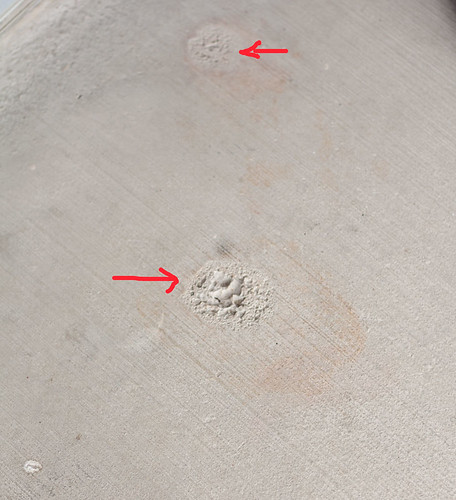 |
| This is what a splash of etchant did to concrete. Now imagine what it could do to your skin! |
So this isn't a tutorial - I don't want your third degree chemical burns on my conscience! If you're interested in metal etching, I strongly encourage you to take a class from a qualified instructor who can walk you through the safe use of the chemicals and how to troubleshoot when you run into problems, which you inevitably will. (If you're in the San Antonio, Texas area, I highly recommend
Wired Designs Studio - they offer classes in all things metal, wire, metal clay, and glass fusing.)
The lovely Gail Stouffer walked us through marking up our metal sheet with resist.
 |
| The lovely Gail is not actually teaching in this photo. Use your imagination! |
"Resist" can be any waterproof material that will
resist the action of the etchant. Basically, the metal will stay unchanged under the resist while the metal around it will be etched away, resulting in a raised pattern. In our case, we used a waterproof stamping ink called Staz-on.
 |
| I loved the wood-grain stamp, but couldn't find on at my local stamp store |
Once we'd played around with some designs and the ink on our sheets were dry, we headed outside to mix up some chemicals and start the etching process.
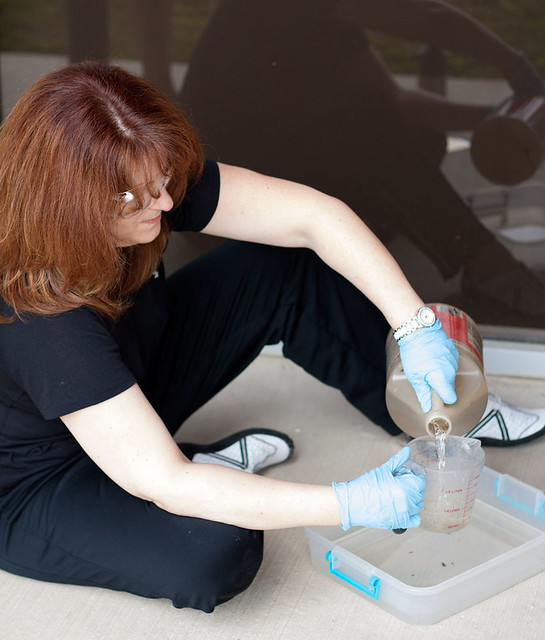 |
| Note the gloves and safety glasses! |
The etchant started out clear, but as it ate away the copper in the metal sheet, it began to turn green.
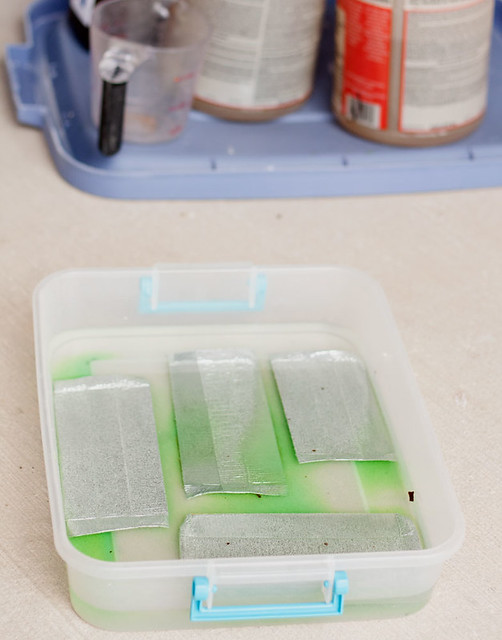 |
| Not lime jello! |
The first round of etching only took 30 minutes, and we got a nice deep etch with lots of detail.
 |
| Before and after |
When we cleaned up the panels and started cutting out the designs, it all started to come together. I was particularly fond of these two sections, which really popped when I lightly patina'd them.
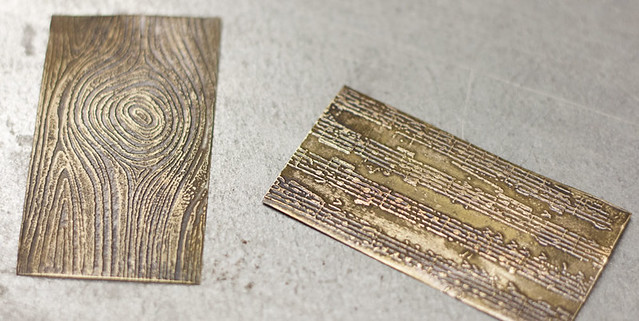 |
| Woodgrain etch (left) and music sheet etch (right) |
Our second etch wasn't quite so successful. The etchant by this time was a bright green - like lime jello - but it should have had plenty of "oomph" to give us a good etch. After nearly an hour, the etch was still very shallow - more of a polished area. Even cleaned and with a patina on it, the pattern was hard to see and the metal felt nearly completely smooth.
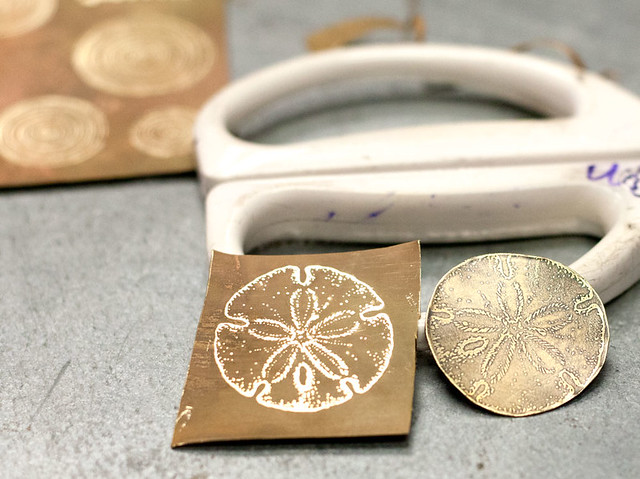 |
| Neutralized but uncleaned sand dollar etch (left); cleaned and patina'd sand dollar etch (right) |
If I were doing it over again, I would have left the second batch in the etchant a little longer and put them in face up. But since we were getting to the end of the day and had to clean and close up the studio, we went with what we had. Obviously I need to experiment more!
So while the process is a little involved and I don't love having all those chemicals around, the result is totally worth it. As a matter of process, I think it probably makes sense to mark up a bunch of metal sheet and spend an afternoon once or twice a month just etching it all. Then I'll have lots of custom-patterned metal to make components with when the mood strikes me. This is the first pair of earrings I made with the patterned brass (and also my first attempt at this stirrup-style bail, which kicked my butt).
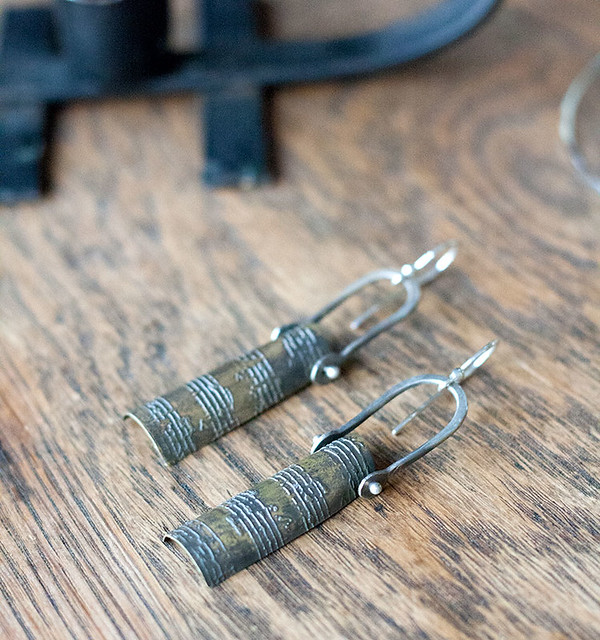 |
| The stirrup bail/tops on these earrings kicked my butt - I need more practice on that technique! |
All in all, if metal is your thing, I highly recommend adding an etching class to your class schedule sometime soon. It's a great, flexible, and customizable technique that will really expand your repertoire.
Until next time!











WOW, great post Francesca, welcome to our group!!!
ReplyDeleteThanks so much, Kristi! I'm really glad to be here! :-)
DeleteGreat post Francesca, especially as I have an etching course booked for next month!
ReplyDeleteLesley, make sure you update us on your thoughts - I'll be curious to see what method your instructor uses, because there are several. And I can't wait to see what you make!
DeleteEnjoyed hearing about your etching adventure, Francesca! Love the earrings...that stirrup bail is one of the things I learned at ArtBliss and it is deceivingly simple looking!
ReplyDeleteSo Melissa, did the second ball on the through pin kick your butt too?? Is there a secret? Seriously, I got sooooo frustrated - but I do like the end result. :-)
DeleteI LOVE those earrings! The results from etching are so amazing, but the chemicals are so scary. I can hardly wait to see what else you make with your new technique
ReplyDeleteThe chemicals freaked me out a little bit too, but in the end it probably isn't any more dangerous than setting up and working with an oxy/acetylene torch - which also freaks me out. :-)
DeleteI enjoyed reading how this is done and the resulting earring rock!!!
ReplyDeleteThanks, Linda - it was a lot of fun!
DeleteThat was a totally cool post, Francesca. I'm so glad to hear that this needs a qualified instructor, since I tend to look at something and just go full tilt into it. I'm also glad to see the steps, because I kept thinking from the first pic with all the different patterns on it, that the whole piece was going to be one item. It never occurred to me that you would cut it up into smaller sections. Duh. I love the result of the earrings, that is where your creative talent shines so clearly. I think the idea of etching a bunch a few times a month is very sensible.
ReplyDeleteThanks, Shirley - I tend to go full-tilt into things too, but I have really benefited from taking classes this year. I'm not saying that there isn't room for experimentation and learning by doing, but with the chemicals involved, I think it makes sense to get some good instruction.
DeleteGlad you like the earrings - I do too! I've been wearing them almost non-stop since I made them! :-)
Very cool! The etching is so wonderful!
ReplyDeleteThanks, Linda - I'm looking forward to experimenting more with it. I think it has tons of potential!
DeleteGreat post - I enjoyed following the process!
ReplyDeleteThanks, Karen!
DeleteI agree with your idea to etch a batch of metal every once in a while - makes it worthwhile to clear everything, tarp, glove up... I have etched sporadically for five years or so - whenever a piece really called for it. And I dont do it more often for all the reasons you cited. I was using plain old ferric chloride tho - stains concrete but doesnt eat it! What did you use?
ReplyDeleteThe earrings are fab! I love the bail! Worth it, IMHO. Looking forward to more of your experiments in the future!
As Gail mentions below, the items are all readily available at the pool and drug store. I've been doing more reading on it since the class, and it turns out that there are methods of "recharging" the etchant so that it can be used nearly indefinitely. When you do need to dispose of it, it can be safely neutralized with baking soda - a huge improvement over the ferric chloride, I think.
DeleteThat's a great post Francesca! I love the wood grain texture.
ReplyDeleteThanks, Jo - I do too! I'm on the lookout for a stamp like that but so far no luck. I just love the big knot in the middle!
DeleteThis is a fascinating post! It makes me want to try etching sometime, though the chemicals sound a little scary.
ReplyDeleteHey Barb - don't be intimidated by the chemicals. Like most things in a jewelry studio (torches, pickle, patina, etc.), everything has some measure of risk and we have to learn to use each thing safely. Find a class in your area and get some basic safety training - you'll do great!
DeleteVery interesting. It's fun to see how the work turns out. Love the detail in those musical notes ;) So how do you safely dispose of the used etchant?
ReplyDeleteOnce it is neutralized, it can just be poured out in your garden somewhere. It becomes completely inert. :-)
DeleteThe chemicals, which you need to have a healthy respect for are items found in a pool store. They can be safely neutralized with baking soda. This makes them much more environmentally friendly. I no longer use Ferric Chloride, which needs to go to the dump.
ReplyDeleteThanks Francesca for the kind words! You're always a pleasure!
Aw, thanks Gail! Back atcha!
DeleteFrancesca that was an amazing post!!! I loved seeing the steps! I think I will leave it to experts like you though. I would totally be the one with third degree burns! LOL
ReplyDeleteThanks, Kristen - but I'm hardly an expert after one class! I have a lot more experimentation to do before I feel completely comfortable with it, but I sure do like the results so far. :-)
DeleteFabulous post! I will definitely have to look into etching and seek out a class one of these days!
ReplyDeleteThanks for sharing your experience!
ReplyDeleteI tried this method (I think) it is peroxide and concrete cleaner right? I didn't get as deep of an etch as I can with ferric chloride but then my measurements could be off. Does your teacher sell a tutorial or is there a way I can get the proper measurements? I am worried I have been doing it wrong and I would like to move away from ferric chloride if I can.
ReplyDeleteThanks
Shannon
formysweetdaughter@me.com